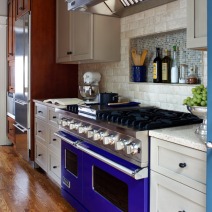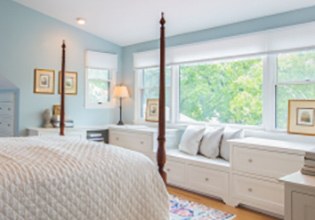Architecture Terms & Definitions
Want to Learn More About Wentworth?
When talking to an architect or builder, it can be helpful to know basic terminology and architectural vocabulary you may encounter. We’ve compiled a list of important architectural terms.
Architecture: The art or practice of designing and constructing buildings.
Balconet: A false balcony or railing at the outer plane of a window.
Balustrade: A railing composition composed of upper and lower rails, balusters, and pedestals. Materials used can range from stone to brick, wood, and sheet metal.
Belt course: Also known as a stringcourse. A projecting horizontal molding separating parts of a wall surface in a facade.
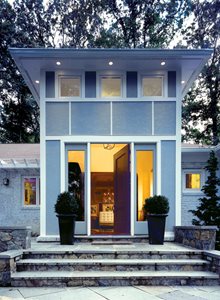
Brackets: Applied ornamental elements often used at a cornice or to flank windows and doors.
Brick header: A brick oriented with the smaller end exposed on the face of the wall and smaller dimension vertical; typically placed over window and door openings.
Canopy: A projecting roof structure that shelters an entrance.
Casement: A single window sash hinged on one side that swings open.
Chamfer: A 45-degree bevel cut at an outside corner of a building element, often seen in wood, stone, or brick.
Chimney pot: A decorative terra cotta chimney extension usually placed above a brick or stone chimney.
Circulation: Used to describe the flow of people throughout a home or building.
Clapboard: One of a series of boards used for siding. It is usually installed horizontally, and the board is most often tapered in cross-sections.
Corinthian: The most ornate and recent of the Greek classical order. The capital’s design is heavily ornamented.
Cornice: The projecting moldings that form the top band of an entablature or wall.
Cresting: A repetitive metal ornament installed at a roof ridge or parapet.
Cupola: A small structure projecting above a roof that provides ventilation and can serve as a “look-out.”
Dependency: A subsidiary building connected to the main building, often one of a symmetrical grouping.
Doric: The Doric order, the earliest type of classical Greek architecture, has a simple yet powerful capital design.
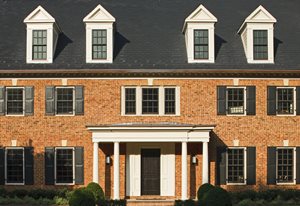
Dormer: A small structure that projects from a sloping roof, with a window in the facade face.
Double-hung window: A window with top and bottom sashes that slide past each other vertically.
Eaves: The projecting overhang at the lower edge of a roof.
Entablature: The horizontal band of elements above the column capitals in classical architecture.
Facade: The exterior faces of a building, often used to refer to the wall in which the building entry is located.
Frieze: The flat, middle portion of an entablature (sometimes decorated).
Gable: The wall that encloses the end of a gable roof; triangular gable end below a roof overhand.
Gambrel: A roof shape characterized by a pair of shallow pitch slopes above a steeply pitched slope on each side of a center ridge.
Half-timbered building: A building constructed with timber frame filled with plaster or brick.
Hip roof: A roof that slopes inward from all four exterior walls.
Ionic: TheIonic order from the Greek classical styles distinctive by the volutes (spiral scroll-like ornaments) used in the capital’s design.
Mansard: A two-pitched roof with a steep lower slope that typically rises to a more gently sloped upper portion. The space formed by the mansard roof allows for additional living space.
Motif: A theme or predominant feature of a design.
Neo-colonial: Residences built after 1955 with allusions of the colonial revival architectural style.
Ogee cap: A molding with an S-shaped cross-section used on top of a baseboard or other structure.
Oriel: A bay window cantilevered out from a facade that starts above the ground level.
Palladian: Neo-classical architecture in the style modeled after the Italian architect Andrea Palladio aka Andrea di Pietro Della Gondola.
Parapet: The portion of wall that projects above the adjacent roof.
Pediment: The triangular gable end of a classical building, or the same form used elsewhere in the building.
Pier: A square or rectangular masonry or wood pier that supports a building and carries the weight of it down to the ground.
Post and beam construction: A simple building framing system that uses a series of vertical posts and horizontal beams.
Quoin: A large rectangular block of stone or brick (sometimes wood) used to accentuate an outside corner of a building, typically in a toothed form with alternate quoins projecting and receding from the corner.
Rosette: A bas-relief ornament (sometimes painted) in the form of a stylized flower.
Rough-hewn: Lumber left exposed in construction that looks hand-cut and is heavily textured.
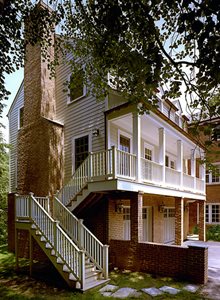
Sash: The part of a window frame that holds the glazing, usually moveable or fixed.
Shed roof: A roof with a single slope and rafters spanning from one wall to the other.
Sidelights: Narrow windows flanking an entry door.
Spandrel panel: The panel formed by the bottom of a window and the head of a lower window.
Spire: A cone-shaped roof element with a steep point.
Terra cotta: Fired ceramic clay used in architectural wall elements or ornaments.
Transom: A small window placed above a door or window.
Turret: A small tower at the corner of a building.
Veneer: A thin decorative finish typically made of brick, stone, or stucco.
Verge board: Decorative boarding (also called bargeboard) along a projecting roof eave. It is often carved or scrolled and is highly ornamental.
Vitrolite: Panels formed of clear glass with color glass laminated to one side and used as a wall veneer.
Window hood: A projecting shelf-like decorative element over a window.
X bracing: A pair of diagonal braces or struts from corner to corner forming an “X.”
Don’t see the term you were looking for in the list above? Contact our architects in Maryland today to learn more about home construction terms and definitions!



